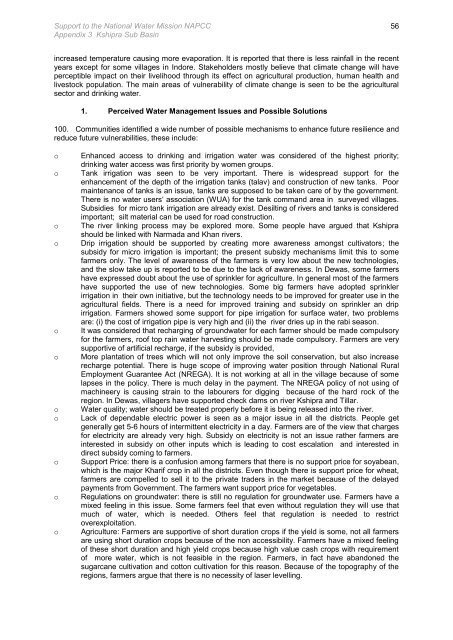Kshipra Sub Basin - Asian Development Bank
Kshipra Sub Basin - Asian Development Bank
Kshipra Sub Basin - Asian Development Bank
Create successful ePaper yourself
Turn your PDF publications into a flip-book with our unique Google optimized e-Paper software.
Support to the National Water Mission NAPCC<br />
Appendix 3 <strong>Kshipra</strong> <strong>Sub</strong> <strong>Basin</strong><br />
increased temperature causing more evaporation. It is reported that there is less rainfall in the recent<br />
years except for some villages in Indore. Stakeholders mostly believe that climate change will have<br />
perceptible impact on their livelihood through its effect on agricultural production, human health and<br />
livestock population. The main areas of vulnerability of climate change is seen to be the agricultural<br />
sector and drinking water.<br />
1. Perceived Water Management Issues and Possible Solutions<br />
100. Communities identified a wide number of possible mechanisms to enhance future resilience and<br />
reduce future vulnerabilities, these include:<br />
o Enhanced access to drinking and irrigation water was considered of the highest priority;<br />
drinking water access was first priority by women groups.<br />
o Tank irrigation was seen to be very important. There is widespread support for the<br />
enhancement of the depth of the irrigation tanks (talav) and construction of new tanks. Poor<br />
maintenance of tanks is an issue, tanks are supposed to be taken care of by the government.<br />
There is no water users‘ association (WUA) for the tank command area in surveyed villages.<br />
<strong>Sub</strong>sidies for micro tank irrigation are already exist. Desilting of rivers and tanks is considered<br />
important; silt material can be used for road construction.<br />
o The river linking process may be explored more. Some people have argued that <strong>Kshipra</strong><br />
should be linked with Narmada and Khan rivers.<br />
o Drip irrigation should be supported by creating more awareness amongst cultivators; the<br />
subsidy for micro irrigation is important; the present subsidy mechanisms limit this to some<br />
farmers only. The level of awareness of the farmers is very low about the new technologies,<br />
and the slow take up is reported to be due to the lack of awareness. In Dewas, some farmers<br />
have expressed doubt about the use of sprinkler for agriculture. In general most of the farmers<br />
have supported the use of new technologies. Some big farmers have adopted sprinkler<br />
irrigation in their own initiative, but the technology needs to be improved for greater use in the<br />
agricultural fields. There is a need for improved training and subsidy on sprinkler an drip<br />
irrigation. Farmers showed some support for pipe irrigation for surface water, two problems<br />
are: (i) the cost of irrigation pipe is very high and (ii) the river dries up in the rabi season.<br />
o It was considered that recharging of groundwater for each farmer should be made compulsory<br />
for the farmers, roof top rain water harvesting should be made compulsory. Farmers are very<br />
supportive of artificial recharge, if the subsidy is provided,<br />
o More plantation of trees which will not only improve the soil conservation, but also increase<br />
recharge potential. There is huge scope of improving water position through National Rural<br />
Employment Guarantee Act (NREGA). It is not working at all in the village because of some<br />
lapses in the policy. There is much delay in the payment. The NREGA policy of not using of<br />
machineery is causing strain to the labourers for digging because of the hard rock of the<br />
region. In Dewas, villagers have supported check dams on river <strong>Kshipra</strong> and Tillar.<br />
o Water quality; water should be treated properly before it is being released into the river.<br />
o Lack of dependable electric power is seen as a major issue in all the districts. People get<br />
generally get 5-6 hours of intermittent electricity in a day. Farmers are of the view that charges<br />
for electricity are already very high. <strong>Sub</strong>sidy on electricity is not an issue rather farmers are<br />
interested in subsidy on other inputs which is leading to cost escalation and interested in<br />
direct subsidy coming to farmers.<br />
o Support Price: there is a confusion among farmers that there is no support price for soyabean,<br />
which is the major Kharif crop in all the districts. Even though there is support price for wheat,<br />
farmers are compelled to sell it to the private traders in the market because of the delayed<br />
payments from Government. The farmers want support price for vegetables.<br />
o Regulations on groundwater: there is still no regulation for groundwater use. Farmers have a<br />
mixed feeling in this issue. Some farmers feel that even without regulation they will use that<br />
much of water, which is needed. Others feel that regulation is needed to restrict<br />
overexploitation.<br />
o Agriculture: Farmers are supportive of short duration crops if the yield is some, not all farmers<br />
are using short duration crops because of the non accessibility. Farmers have a mixed feeling<br />
of these short duration and high yield crops because high value cash crops with requirement<br />
of more water, which is not feasible in the region. Farmers, in fact have abandoned the<br />
sugarcane cultivation and cotton cultivation for this reason. Because of the topography of the<br />
regions, farmers argue that there is no necessity of laser levelling.<br />
56
















